
a)
To find: Draw the
The scatter plot will be as follows.
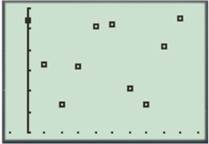
Given information:
The given table is as follows.
| Date | Day | Distance (Mm) |
| Mar 19 | ||
| Mar 25 | ||
| Mar 31 | ||
| Apr 6 | ||
| Apr 12 | ||
| Apr 18 | ||
| Apr 24 | ||
| Apr 30 | ||
| May 6 | ||
| May 12 |
Calculation:
Enter the day values on
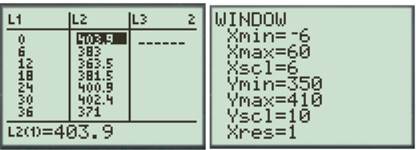
Figure (1)
The scatter plot will be as follows.
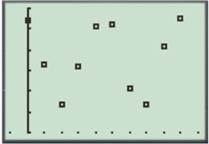
Figure (2)
b)
To find: The equation of best fit sine curve and superimposed it on the scatter plot.
The equation is
Calculation:
Use the
The equation is,
The superimposed graph is as follows.
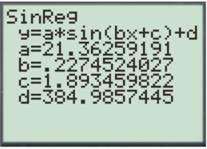
Figure (3)
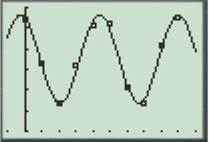
Figure (4)
Therefore, the equation is
c)
To find: The approximate number of days from apogee to apogee.
The approximate number of days from apogee to apogee is
Calculation:
The number of days from apogee to apogee is the period of the sine regression which is
Therefore, this is very close to the fact that the moon orbits the Earth once every
d)
To find: The approximate distance at perigee.
The approximate distance at perigee is
Calculation:
Use the
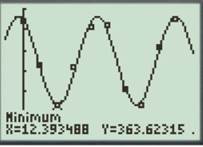
The perigee is about
Therefore, the approximate distance at perigee is
e)
To find: The date on which on which Moon is 359000 km from Earth and also explain the reason.
The date is day
Calculation:
The distance of
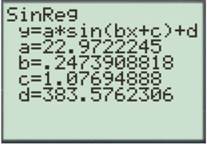
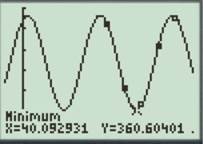
Therefore, the date is day
Chapter 5 Solutions
PRECALCULUS:GRAPHICAL,...-NASTA ED.
- please question 9arrow_forwardUse the definite integral to find the area between the x-axis and f(x) over the indicated interval. Check first to see if the graph crosses the x-axis in the given interval. 3. f(x) = 4x; [-5,3]arrow_forwardUse the definite integral to find the area between the x-axis and f(x) over the indicated interval. Check first to see if the graph crosses the x-axis in the given interval. f(x)=3e-4; [3,3]arrow_forward
- A small company of science writers found that its rate of profit (in thousands of dollars) after t years of operation is given by P'(t) = (7t + 14) (t² + 4t+7) * (a) Find the total profit in the first four years. (b) Find the profit in the sixth year of operation. (c) What is happening to the annual profit over the long run?arrow_forwardCalculus III May I have an expert explained how the terms were simplified into 6(3-x)^2? Thank you,arrow_forwardCalculus III May I have an expert explain how the integrand was simplified into the final for form to be integrated with respect to x? Thank you,arrow_forward
- Calculus lll May I please have the semicolon statement in the box defined with explanation? Thank you,arrow_forwardCalculus lll May I please have the solutions for the following blank lines? Thank you,arrow_forwardCalculus lll May I please have the solution for the following example? Thank you,arrow_forward
- Calculus lll May I please have numbers 1 and 2 explanations resolved? Thank you,arrow_forward5:38 Video Message instructor Submit Question ||| Darrow_forward8:38 *** TEMU TEMU -3 -2 7 B 2 1 & 5G. 61% 1 2 -1 Based on the graph above, determine the amplitude, period, midline, and equation of the function. Use f(x) as the output. Amplitude: 2 Period: 2 Midline: 2 ☑ syntax error: this is not an equation. Function: f(x) = −2 cos(πx + 2.5π) +2× Question Help: Worked Example 1 ☑ Message instructor Submit Question ||| <arrow_forward
 Calculus: Early TranscendentalsCalculusISBN:9781285741550Author:James StewartPublisher:Cengage Learning
Calculus: Early TranscendentalsCalculusISBN:9781285741550Author:James StewartPublisher:Cengage Learning Thomas' Calculus (14th Edition)CalculusISBN:9780134438986Author:Joel R. Hass, Christopher E. Heil, Maurice D. WeirPublisher:PEARSON
Thomas' Calculus (14th Edition)CalculusISBN:9780134438986Author:Joel R. Hass, Christopher E. Heil, Maurice D. WeirPublisher:PEARSON Calculus: Early Transcendentals (3rd Edition)CalculusISBN:9780134763644Author:William L. Briggs, Lyle Cochran, Bernard Gillett, Eric SchulzPublisher:PEARSON
Calculus: Early Transcendentals (3rd Edition)CalculusISBN:9780134763644Author:William L. Briggs, Lyle Cochran, Bernard Gillett, Eric SchulzPublisher:PEARSON Calculus: Early TranscendentalsCalculusISBN:9781319050740Author:Jon Rogawski, Colin Adams, Robert FranzosaPublisher:W. H. Freeman
Calculus: Early TranscendentalsCalculusISBN:9781319050740Author:Jon Rogawski, Colin Adams, Robert FranzosaPublisher:W. H. Freeman
 Calculus: Early Transcendental FunctionsCalculusISBN:9781337552516Author:Ron Larson, Bruce H. EdwardsPublisher:Cengage Learning
Calculus: Early Transcendental FunctionsCalculusISBN:9781337552516Author:Ron Larson, Bruce H. EdwardsPublisher:Cengage Learning





